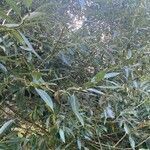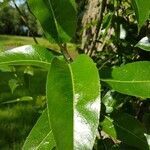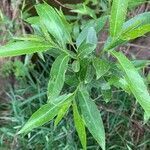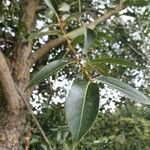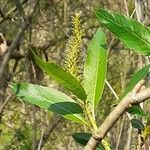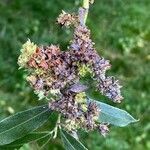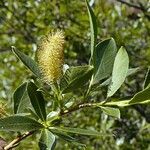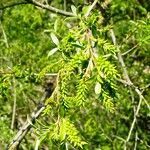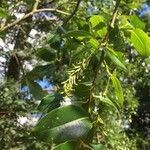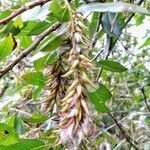Shrubs or trees, 5-15 m. Stems: branches flexible at base, brownish or yellow-green, highly glossy, glabrous; branchlets yellow-green, red-brown, or brownish, glossy, glabrous. Leaves: stipules absent or rudimentary on early ones, rudimentary or foliaceous on late ones, apex rounded; petiole deeply to shallowly grooved adaxially, 5-15 mm, with pairs or clusters of spherical glands distally or throughout, glabrous adaxially; largest medial blade hypostomatous, narrowly elliptic, elliptic, or lanceolate, 50-135 × 20-50 mm, 2-4 times as long as wide, base convex, margins slightly revolute or flat, serrulate, apex acuminate, abaxial surface pale not glaucous, glabrous, adaxial highly glossy, glabrous; proximal blade margins entire or serrulate; juvenile blade reddish, glabrous abaxially. Catkins: staminate 27-81 × 9-13 mm, flowering branchlet 9-21 mm; pistillate moderately to densely flowered, slender or stout, 29-68 × 7-15 mm, flowering branchlet 9-42 mm; floral bract 2-4 mm, apex acute or rounded to truncate, entire or toothed, abaxially sparsely hairy (mainly proximally), hairs wavy or straight. Staminate flowers: abaxial nectary 0.6-1.7 mm, adaxial nectary square, ovate, or oblong, 0.5-1.5 mm, nectaries distinct or ± connate and cup-shaped; stamens 4-10; filaments distinct, hairy on proximal 1/2; anthers ellipsoid or globose, 0.5-0.6 mm. Pistillate flowers: (abaxial nectary present or absent), adaxial nectary oblong, square, or ovate, 0.4-0.8 mm, (nectaries distinct or connate and shallowly cup-shaped), shorter than or equal to stipe; stipe 0.5-1.6 mm; ovary pyriform, beak bulged below or tapering to styles; ovules 18-22 per ovary; styles connate or distinct, 0.4-0.6 mm; stigmas flat, abaxially non-papillate with rounded tip, or slenderly cylindrical, 0.4-0.6 mm. Capsules 6-9 mm. 2n = 76.
More
Shrubs or trees to 5 m tall; bark gray or grayish brown. Juvenile branchlets brownish green, grayish green, or grayish brown, glabrous, shiny. Stipules when present oblong or broadly ovate, deciduous, sometimes absent; petiole 2-14 mm, apex glandular; leaf blade broadly lanceolate, ovate-oblong, or elliptic-lanceolate, 3-13 × 2-4 cm, leathery, viscid when young, abaxially greenish, pruinose or glabrous, adaxially dull green, shiny, base obtuse or cuneate, margin glandular serrate, apex acuminate. Male catkin 2-4(-7) × 1-1.2 cm; bracts green, lanceolate, oblong, elliptic, deltoid-obovate, or obovate-oblong, ca. 2.5 mm, 2-or 3-veined, margin glandular dentate or entire, apex rounded or obtuse. Male flower: glands cylindric, ca. 1 mm, adaxial gland usually 2-or 3-lobed; stamens (5 or)6-9(-12); filaments ca. 4.5 mm, unequal, villous at base. Female catkin 2-6 cm × ca. 8 mm. Female flower: adaxial gland 1, rarely 2, 1-or 2-parted, narrowly ovate or ovate, apex truncate, abaxial gland sometimes absent; ovary ovoid-conical, glabrous, subsessile; style and stigma conspicuous, 2-parted. Capsule ca. 9 mm, shiny, shortly stipitate. Fl. Jun, fr. Aug-Sep. 2n = 76.
Much like no. 5 [Salix serissima (L. H. Bailey) Fernald], but the scales hairy only at the base outside, glabrous or nearly so distally; shrub or small tree to 7 m; staminate catkins mostly 3–6+ cm, the pistillate 3.5–7 cm; stamens 4–9, mostly 5; fr 5–8 mm, on pedicels 0.5–1.5 mm; 2n=76. Native of Europe, cult. and occasionally escaped mainly in the n. part of our range; May–June, the fr maturing in mid-and late summer.
A deciduous tree. It grows 15 m tall. It is a broadly spreading tree. The bark is grey-brown with shallow cracks. The leaves are narrowly oval and 12 cm long by 5 cm wide. They taper to a short point. There are fine teeth along the edge. The male and female flowers are both very small. They are in catkins 5 cm long. The fruit is a small green capsule. It releases fluffy white seeds.
Grassy bogs, wet meadows and swampy valleys, inundated areas, and damp woods. Forest tundra, forest and steppe belt; in the mountains up to the forest zone; at elevations up to 2,500 metres.
More
It is native to Asia and Europe. It grows along riverbanks and in meadows. It suits hardiness zones 5-10.
